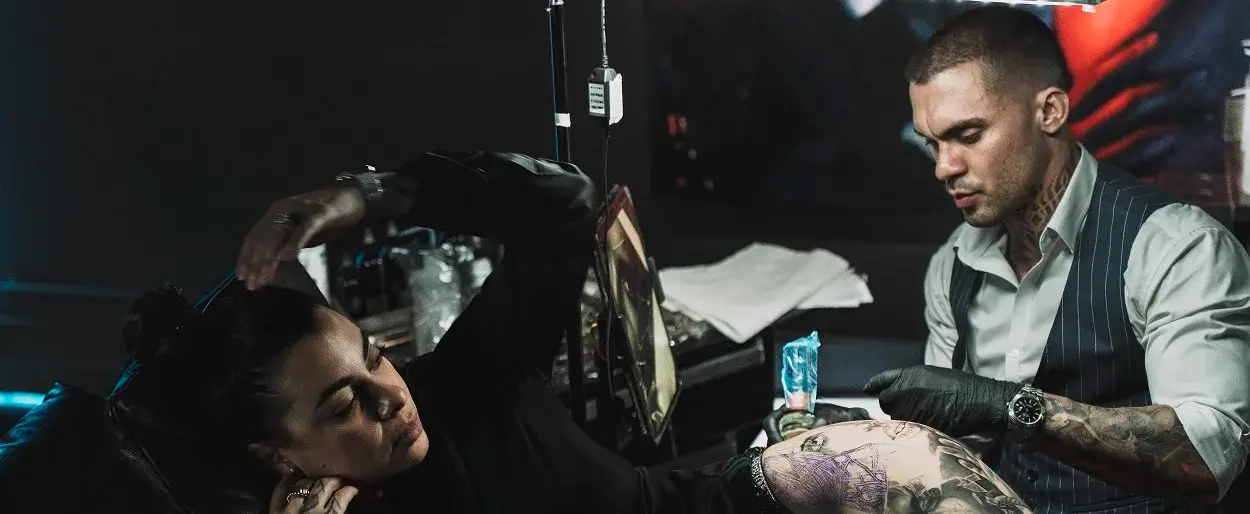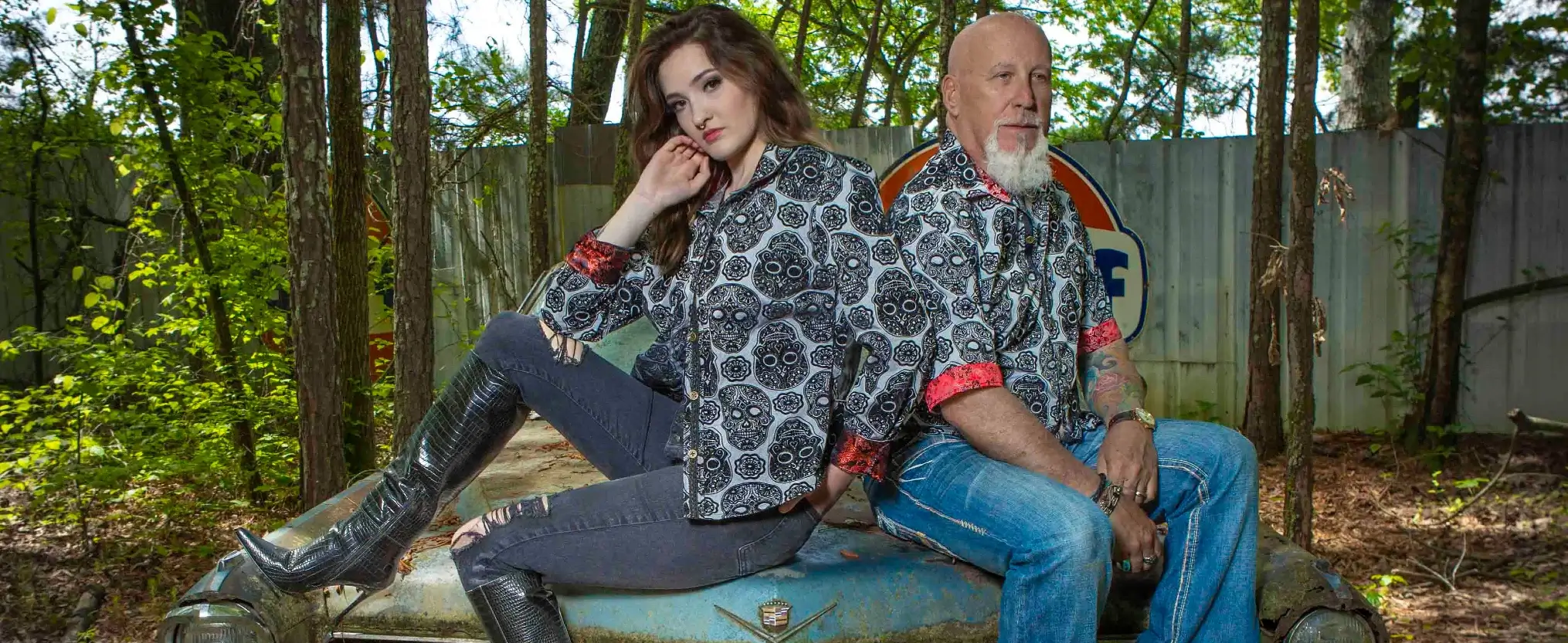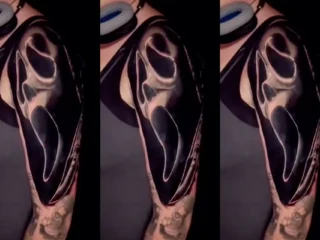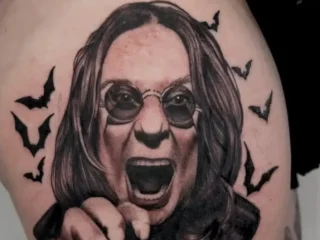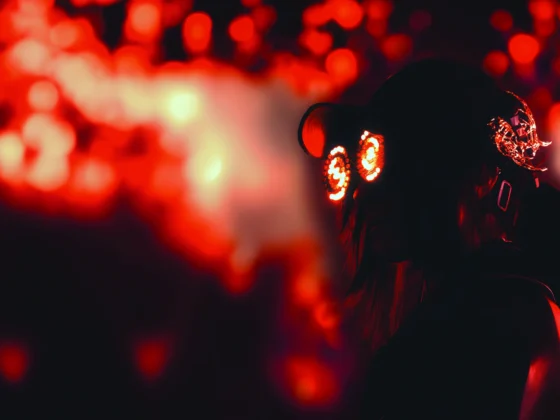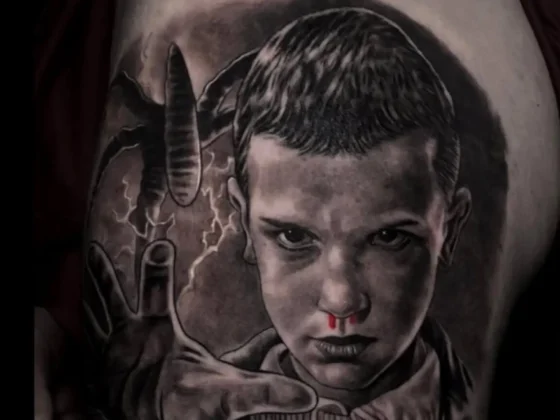Inked Mag Staff
March 25th, 2015
Sailor Jerry’s Secrets As Told By Lance McLain
Inked interviews Lance McLain: The guy that took Sailor Jerry’s seat. “Are you Sailor Jerry?” “Yeah.” “Well okay, Ed Hardy sent me down here. I got work from him and…
Inked interviews Lance McLain: The guy that took Sailor Jerry’s seat.
“Are you Sailor Jerry?”
“Yeah.”
“Well okay, Ed Hardy sent me down here. I got work from him and he said to show you the work.”
Just one year before Norman “Sailor Jerry” Collins passed, Lance McLain paid a visit to the old man when his Navy ship landed in Hawaii, clueless to the fact that he’d soon take Jerry’s seat. McLain has kept under the radar since his start at China Sea Tattoo in 1976, so Inked caught up with the islander and traveled back in time to the early stages of the industry, when Sailor Jerry was raising hell and Lance McLain was fresh in the business. He is one of the most humble human beings I’ve had the pleasure of getting to know, but I don’t think he has a clue just how big a gem he truly is. His stories set me in a trance. I felt as though I was the one drinking beer with Sailor Jerry, getting tattooed by Ed Hardy and settling in the Hawaiian sun. Unfortunately for me that’s not my life but the one belonging to McLain. He has been running his own shop, Dragon Tattoo, in Wahiawa, HI, for the last 27 years. If you’re a sucker for traditional ink, “ya know, hearts and roses and that stuff,” then you’ll be refreshed by McLain’s ability to provide his customers with the experience he grew up with—I’m talking an old school, hand-painted flash on the walls, walk-in street shop. And if you’ve caught trend to modern ink, you still have a lot to learn (and appreciate) from the Navy vet. The old timer shared his thoughts on today’s “frou-frou” tattooing, learning off of Jerry’s flash and Honolulu circa 1976.
You met Ed Hardy while you were still in the navy?
Lance: I met Hardy when I was in San Diego. He had a lot of cool Japanese style designs in his window that stood out. It was rare in those days to come across somebody that was doing Asian style tattooing because in the early ‘70s a lot of the shops still did the eagle or panther military type tattoo. Ya know, hearts and roses. Traditional stuff. Ed was doing these really neat Asian looking dragons and tigers.
So you walked into his shop….
[Ed’s] a pretty easy guy to talk to and right away he got all excited about tattooing and Japanese style tattoos. I was thinking wow this guy has real great enthusiasm—the type that wears off on you. It was infectious. I got a dragon from him that went from the arm onto the chest and a koi fish on the other arm. He was really trying to get the tattoo public interested in that style.
When were you first tattooed?
Just after my 18th birthday by Tennessee Dave. I remember I was with my mom at the market and I saw a man that had a tattoo of a wolf wearing a top hat. It was one of those wolves with the tongue sticking out with a lot of slobber—I was six years old. Ya look at that and that’s the hottest thing you’ve ever seen in your life. Right away I knew I wanted one. A tattoo was the coolest thing that possibly could happen to a person. Of course, you won’t get any support from your parents or anything like that. You’d always hear the regret stories. That didn’t faze me at all. Society doesn’t like it then it makes somebody want it even more.
How did your apprenticeship with Mike Malone begin?
He was in San Diego while I was being tattooed by Ed. Mike was working in Zeke Owen’s shop just up the road. In those days the shops were real close in proximity. Mike Malone knew Ed real well so I walked in and introduced myself and told him I had gotten some recent work from Ed. Mike was real interested in seeing it and he’d let me hang around the shop. He got an offer from Jerry’s widow, Louise, when Jerry passed away. Louise was under strict orders from the old man to sell the shop only to three people that Jerry approved of: Ed Hardy, Zeke Owen or Mike Malone. Ed and Zeke both turned down the offer but Mike took the opportunity. He came over to Hawaii while I was still in the Navy but we kept in contact and eventually he said, “Lance, when you get out of the Navy I’ll be willing to teach you the business if you want to come to Honolulu.”

You landed in Honolulu with Mike, then what?
He had been here for almost two years before I got out of the Navy and started working for him. It was mostly military and locals that we did but business was fairly steady. Mike was a good businessman and he was good to work for. He wanted you to do good work and treat the customers well but he wasn’t a nitpicky worrywart. I was real green in the business and didn’t know a lot but he was patient and taught me to give a proper tattoo. I have to take my hat off to him, he was at least ten years my senior. I was about 24 and he was probably 34 or 35—he was putting up with a kid.
Were you messing around?
I was just dragging my anchor. I wasn’t working in an efficient manner or conducting myself efficiently. I hadn’t realized the value of that yet. Actually, as far as Mike being a fairly big man, he was fast, he could do a very good job of tattooing without wasting a lot of time. He knew the value of efficiency.
How did it feel to be in Jerry’s shop after he passed?
It was scary. I was in the hot seat. Mike was a left handed tattoo artist so if you were sitting in the shop looking out towards the door, he had his workstation on the left hand side. Now I’m right handed, so I was sitting in the same workstation, ya know, Jerry’s old position, and that was closer to the door. People would come in and ask ‘where’s Jerry?’ I’d just say, ‘Jerry passed away, the wife sold the business to Mike Malone and my name is Lance, I work for Mike.’
Did Sailor Jerry influence your work?
Totally. Before Mike took over it was called like Sailor Jerry Tattoo Shop and he changed it to China Sea Tattoo, but Jerry’s designs, all of his original flash and stencils and everything were in the shop still. I learned to tattoo by working off of Jerry’s flash. Working directly off of the old plastic acetate stencils. Everything I did in those days was from Sailor Jerry’s designs. In that shop, seven days a week, it was Sailor Jerry.

Wow, all around you all the time.
All the walls, all the stencils, all the designs were Sailor Jerry. That was a really good opportunity to learn how to tattoo because Jerry’s designs were big, bold designs—old school style, real forgiving. If there was any hiccup in the line or anything like that, you could put a little black shading next to the line and make it straight. A lot of those designs you were able to do without having to walk through a minefield. They were pretty big and open and just solid colors; it was major to learn that way.
What memories do you have of visiting Sailor Jerry while you were in the service?
I was in the Navy and Ed Hardy and Mike Malone always said, ‘when your ship comes through Honolulu you got to stop and see Sailor Jerry!’ So, in fact my ship did stop in Honolulu and the first thing I did was go down to Sailor Jerry’s shop and see the old man. It was easy for me to approach Jerry because they knew each other; it was like I had a membership card because Ed had tattooed me. Jerry was corresponding with Ed quite a bit, exchanging photographs of their tattoos. Ed had made a couple visits to see Jerry so they knew one another well. Gosh, it was about a year or so before he died when I came in.
Jerry was in pretty bad condition because he was a chain smoker, of that generation, a lot of people smoked. I think that took a toll on him. Growing up during the depression and living through World War II aged a person. Plus, Jerry being in the service (he was Merchant Marine during WWII), but he was in the Navy in the 1920s. When the Second World War broke out he tried to get back in the Navy but he had a heart murmur so they wouldn’t take him. The Merchant Marine was a little more lax on that so he went right in and sailed WWII. I believe he had a couple ships blown out from right underneath him; those experiences put a lot of age on you.

Did he ever tattoo you?
No. The four or five days that my ship was in port I did nothing but go down there and if he felt like talking he’d talk. If he was busy with somebody or doing something else I just sat there quietly until he did feel like talking. I glued my butt to the chair and absorbed as much of the ambiance of that shop and whatever Jerry wanted to pass along to me. I was a human sponge.
Anything special he taught you?
The history of that area. He was in the Chinatown area of Honolulu. Tattooing has been going on at Hotel St. since the early 1920s. During the Second World War when a lot of military passed through, you easily had ten or twelve tattoo shops in Chinatown. Jerry came to Honolulu in the early ‘30s, when it was smaller and everyone knew everybody. But the IRS audited him in the ‘50s. He got so angry he closed up business and sailed on an excursion boat for tourists that wanted to see the Pearl Harbor memorial and in 1960 he opened up shop on 1033 Smith Street, where I worked.
What did you guys drink?
Anything with a green bottle.
How wild that you spent all of that time with him and had no idea that you’d start your career in his very seat.
I had no idea that being there, talking to Jerry, a year or so after he passed, I’d be sitting in the same chair that he was sitting in. It never dawned on me. Fate just had its way. It’s miraculous; I didn’t have a clue in those days.
How long were you with Mike?
I started tattooing there in 1976, right at the beginning of the New Year. I was there until the end of ‘79. He opened up a second shop, Floating World Tattoo, in Waikiki, because a lot of the military business was heading there and Chinatown was slowing down. Waikiki was more glamorous. Mike figured if business is going in that direction we should too. After a while Mike realized that was more than he wanted to handle so he offered it to me and I took him up on it right away. I was there for about eight years before moving to Wahiawa and opening Dragon Tattoo.
Lance, I understand that all of the flash on the walls was hand-painted by you, right?
Yeah. Back when I was learning to tattoo, most shops, if they were worth their salt, had hand painted flash on the walls. Certainly Jerry’s did. There were a few suppliers back in the early ‘70s that sold flash but not anything like today where you can go on the Internet to buy and print. You want some new designs on the walls? Sit down and start drawing. Every design was something that potentially a customer would get because they’d pick flash off the wall. They didn’t have a cell phone, they didn’t have internet, none of that. It was of the utmost importance to have a real good selection of designs on the wall. That was part of being in the tattoo business.

Do people still come in and pick flash off the wall?
They do. The internet has made things different but still they enjoy coming into a flash shop and seeing all the designs. Nowadays shops are real different. You got real exclusive tattoo shops where it’s appointment only; maybe they have a doorman and nice books of flash on coffee tables. I’m a big believer if people are looking for that kind of experience with tattooing then that’s great, they have that option. People have a lot more choices now and that’s good. Freedom basically is choice.
There is a huge community for it.
It took a while; it wasn’t something that happened overnight. Nowadays kids are so exposed to tattoos, it’s almost like there’s overexposure; they’ll come into the shop and they’re blasé about it. When I first started working for Mike Malone at Jerry’s, a young service guy walked in and stopped right in the middle of the waiting room as if he realized, wow, I’m in one of these. I’m in a tattoo shop! I’ve heard about these places since I was young and now I’m finally in one. They’d look at the designs with awe. I’m not seeing that these days. It’s like they’re walking into another McDonald’s hamburger restaurant.
Your shop sounds like the good old days.
Well, I’m starting to hear that now there are individuals looking for that genuine tattoo experience. They want to walk in and get something authentic. They don’t want frou-frou tattooing with all the pastel colors and no black outline and all of that. Again, I’m not opposed to that kind of tattooing, I think it’s wonderful that people are getting tattoos that look like oil paintings, that’s a different style that has evolved and it gives people another avenue. I just offer them the experience that I grew up with. That’s the experience that I can pass on to them. I’m seeing people start to appreciate that more so that makes me feel good.
Editor's Picks
Bridging Classical Art and Modern Tattooing
Esteban Rodriguez brings the discipline of classical fine art to the living canvas of skin, creating hyper-realistic tattoos that merge technical mastery with emotional depth.
Show Your Ink Fashions Brings Custom Style to Tattoo Culture
Show Your Ink Fashions creates custom shirts designed to showcase your tattoos as wearable art, blending fashion with personal expression.
The Ultimate “Superman” Tattoo Roundup: Just in Time for Superman’s Return to Screens
With Superman’s big return to theaters, fans are revisiting some of the most iconic ink inspired by the Man of Steel.


